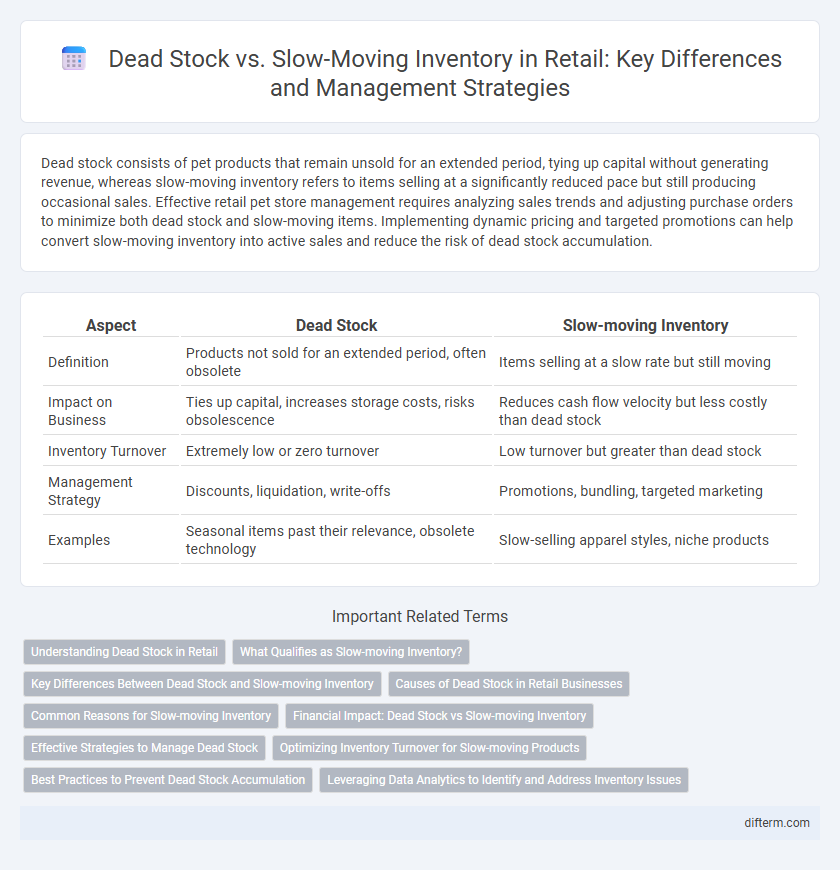Dead stock consists of pet products that remain unsold for an extended period, tying up capital without generating revenue, whereas slow-moving inventory refers to items selling at a significantly reduced pace but still producing occasional sales. Effective retail pet store management requires analyzing sales trends and adjusting purchase orders to minimize both dead stock and slow-moving items. Implementing dynamic pricing and targeted promotions can help convert slow-moving inventory into active sales and reduce the risk of dead stock accumulation.
Table of Comparison
| Aspect | Dead Stock | Slow-moving Inventory |
|---|---|---|
| Definition | Products not sold for an extended period, often obsolete | Items selling at a slow rate but still moving |
| Impact on Business | Ties up capital, increases storage costs, risks obsolescence | Reduces cash flow velocity but less costly than dead stock |
| Inventory Turnover | Extremely low or zero turnover | Low turnover but greater than dead stock |
| Management Strategy | Discounts, liquidation, write-offs | Promotions, bundling, targeted marketing |
| Examples | Seasonal items past their relevance, obsolete technology | Slow-selling apparel styles, niche products |
Understanding Dead Stock in Retail
Dead stock in retail refers to inventory items that have not been sold or used for an extended period, typically due to lack of demand, seasonality, or obsolete trends. These products tie up capital and storage space, negatively impacting cash flow and profitability. Effective management involves identifying dead stock early through inventory turnover analysis and implementing strategies such as discounts, bundling, or liquidation to minimize losses.
What Qualifies as Slow-moving Inventory?
Slow-moving inventory refers to products that have low sales velocity over a specific period, typically remaining in stock longer than expected without frequent turnover. These items often occupy valuable retail space and tie up capital, impacting cash flow and inventory management efficiency. Identifying slow-moving inventory involves analyzing sales performance data, turnover rates, and market demand trends to distinguish it from dead stock, which usually no longer generates sales.
Key Differences Between Dead Stock and Slow-moving Inventory
Dead stock refers to inventory that has not sold for an extended period and is unlikely to sell without significant discounting or repurposing, whereas slow-moving inventory experiences gradual sales but ties up capital and storage space. Dead stock often results from overproduction, obsolete items, or poor forecasting, making it a greater liability than slow-moving goods, which still hold potential value if managed properly. Effective inventory management and demand forecasting are essential to minimize both dead stock and slow-moving inventory, improving cash flow and profitability.
Causes of Dead Stock in Retail Businesses
Dead stock in retail often results from overestimating demand, poor inventory management, and changes in consumer preferences. Seasonal trends, product obsolescence, and inaccurate sales forecasting also contribute to accumulating unsellable inventory. Supplier issues and ineffective promotional strategies further exacerbate dead stock challenges in retail businesses.
Common Reasons for Slow-moving Inventory
Slow-moving inventory often results from overordering, inaccurate demand forecasting, and seasonal product mismatches in retail operations. Poor inventory management and lack of market trend analysis contribute to excess stock that fails to sell promptly. Retailers facing these challenges experience reduced cash flow and increased storage costs, distinguishing slow-moving items from dead stock, which is typically obsolete or unsellable.
Financial Impact: Dead Stock vs Slow-moving Inventory
Dead stock ties up capital without generating revenue, leading to increased holding costs and potential write-offs that negatively impact a retailer's profitability. Slow-moving inventory, while still generating some sales, causes cash flow delays and higher carrying expenses, reducing overall financial efficiency. Effective inventory management strategies targeting both dead stock and slow-moving items can significantly improve a retailer's working capital and profit margins.
Effective Strategies to Manage Dead Stock
Implementing data-driven inventory analysis helps retailers identify dead stock early, enabling targeted discounting and bundling strategies that convert stagnant items into sales. Utilizing demand forecasting and replenishment automation minimizes overstock, reducing the risk of dead merchandise accumulation. Collaborating with suppliers for flexible return policies and adopting inventory clearance events further mitigates financial losses associated with dead stock.
Optimizing Inventory Turnover for Slow-moving Products
Optimizing inventory turnover for slow-moving products involves accurate demand forecasting and targeted promotions to reduce holding costs and free up capital. Implementing data-driven inventory management systems helps identify slow movers early, enabling strategic markdowns or bundling to accelerate sales. Efficient inventory turnover improves cash flow and minimizes the risk of dead stock accumulation, enhancing overall retail profitability.
Best Practices to Prevent Dead Stock Accumulation
Implementing real-time inventory tracking and demand forecasting reduces dead stock risks by aligning purchasing decisions with actual sales trends. Regularly analyzing sales velocity and customer preferences enables timely markdowns or promotional strategies to clear slow-moving items before they become dead stock. Collaborating closely with suppliers for flexible order quantities and return policies minimizes overstock and enhances inventory turnover efficiency.
Leveraging Data Analytics to Identify and Address Inventory Issues
Leveraging data analytics in retail reveals patterns distinguishing dead stock from slow-moving inventory, enabling precise inventory management. Advanced algorithms analyze sales velocity, seasonal trends, and consumer demand to flag stagnant items and optimize stock levels. Retailers can implement targeted promotions and inventory adjustments based on data-driven insights, reducing carrying costs and improving cash flow.
Dead Stock vs Slow-moving Inventory Infographic

 difterm.com
difterm.com